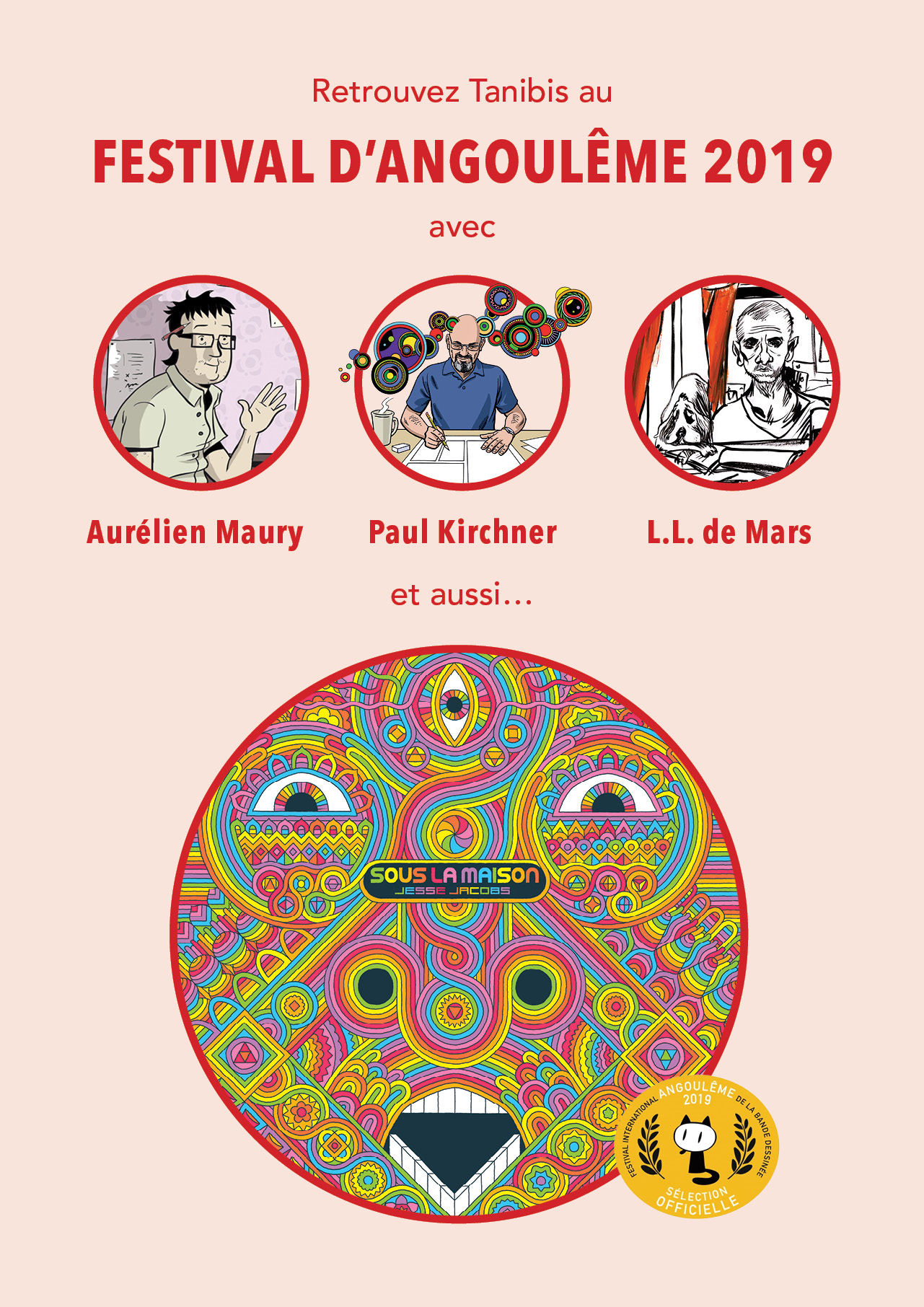
Du 24 au 27 janvier 2019, plus d'infos sur bdangouleme.com.
dimanche 20 janvier 2019 - Rendez-vous

Du 24 au 27 janvier 2019, plus d'infos sur bdangouleme.com.
/// aucun commentaire ///
jeudi 8 novembre 2018 - Général
On the occasion of the release of his new book Hieronymus & Bosch, Paul Kirchner tells us the story behind the strip.
The character that would one day become Hieronymus first appeared on the cover of my 1987 anthology, Realms, in which he is one of a number of odd characters traveling a network of floating stone paths. This Hieronymus had a staff with a lantern atop it, a dagger in his belt, and a dolphin under his arm. I liked the look of him and did a different version, which I had printed on my envelopes. This one had a tuna instead of a dolphin and a flintlock pistol instead of a dagger.

Around 2005, I began thinking about a comic strip to be set in Hell, specifically Hieronymus Bosch's vision of Hell. I kept a file of sketches and notes, but I was never able to develop any ideas that worked. I read several books on Hell, looking for direction. Dante was too daunting, so I tried Dante's Inferno in Plain English. Still too dense for me, I resorted to an excellent graphic novel, Dante's Inferno, by Hunt Emerson and Kevin Jackson. To the extent I was influenced by Dante’s vision, it was mostly in having a variety of punishment, each appropriate to the specific sin. I also read Inferno and Escape From Hell by Larry Niven and Jerry Pournelle. These books, especially the second, were inspirational. The story follows Dante's vision but introduces the rather Buddhist concept that the residents of Hell have chosen to be there, if only subconsciously. They need to work out some basic flaw in their nature and once they have done so they are free to leave.
In 2014 I gave up the idea of using Bosch's imagery and went with my own vision of Hell. I visualized it as being somewhat like real life, except that it’s gloomy and shabby and everything always goes terribly wrong. It has an eternally black, starless sky, volcanoes spewing noxious fumes, and a landscape spotted with tumble-down ruins. Occasionally one comes across an apple—a delicious red apple!—but it is almost always the bait for a practical joke. One is bullied by demons, but not to the extent that one sees in medieval depictions. The residents are not hacked into pieces or impaled on spikes, but poked, prodded, and shat upon. People often talk about all the shit they have to put up with in life, so I figured that if they end up in Hell they will have to put up with a great deal more. My Hell is less about torment than frustration, aggravation, and humiliation, and shit seemed a good way to depict that.
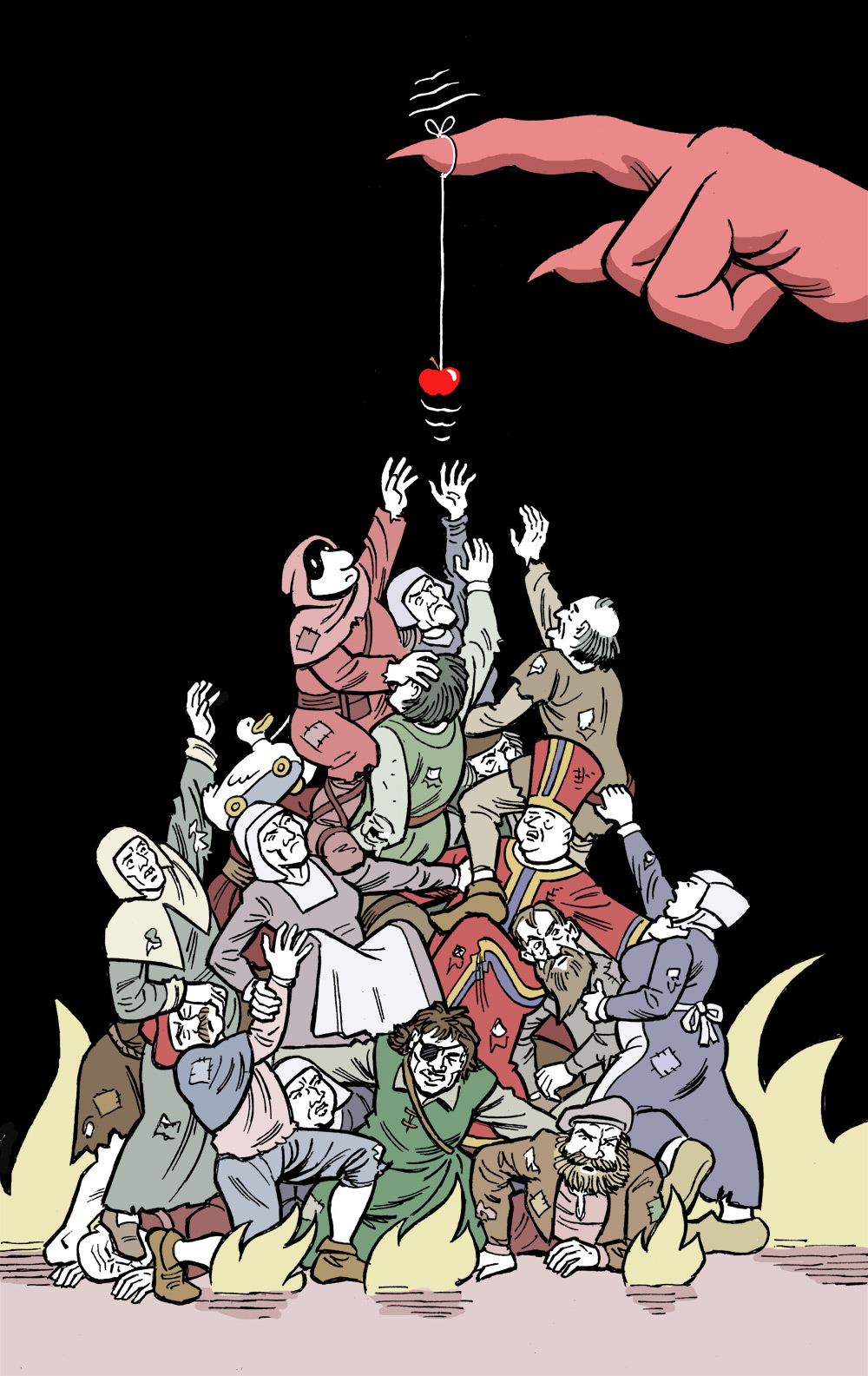
I needed to make some changes to Hieronymus in order to fit him into my Hell. Gone was the pistol, of course--that would have been confiscated at the gate. Gone also was the staff and the fish, as he would need his hands free to perform various functions. Instead of holding a fish, he now pulls a toy wooden duck behind him. It is not very good company, but he's stuck with it.
As far as style, I wanted to give it a rough look like a woodcut. I'm not sure I succeeded in that, but the shading at least is done like the lines in a woodcut rather than the cross-hatching I used for the bus. I never ruled a line in Hieronymus & Bosch as I wanted everything to look a little irregular.
At the time, I was calling my strip "Hell Mall." I drew up the first half dozen strips around the same time that I was drawing the new bus strips that were published in the bus 2. I had submitted the bus strips to Ryan Flanders, an editor at MAD magazine, but he warned me that if MAD published them they would take ownership of the entire property, which was unacceptable to me. Unsure how far I could take "Hell Mall," I submitted that to MAD, willing to give up the rights if they wanted it. MAD turned it down. Ryan wrote, "We've decided that 'Hell Mall' isn't a good fit for MAD. We took it under very serious consideration, but we ultimately decided it's too conceptual. We prefer to give it to 'em straight."
In retrospect, I'm very glad that MAD had turned it down. MAD publishes only bimonthly and many of its regular comics are not featured in every issue, so my strip--which would no longer actually be mine-- would have earned me little money and gotten little exposure.

Ideas kept coming to me and I kept doing strips, hoping to eventually have enough for a book. I played with various names for the strip, and finally decided upon "Hieronymus & Bosch," the names I had given the man and duck. When I was doing the bus, it had never occurred to me to give the commuter a name, but I felt that this character would be easier to relate to if he had one.
This cartoon is some ways similar and in others quite different than the bus. Both star a hapless character who seems bewildered by the world he inhabits, but who attempts to navigate it as best he can. Both strips use visual gags with no dialog. The style is more cartoonish, which is a way to soften the cruelty and put it in the realm of a Warner Bros. cartoon. (Though I did decide to put little penises on the demons so they wouldn't be mistaken for Disney characters.) Both strips use surrealistic jokes, but the bus uses them almost exclusively while Hieronymus & Bosch uses more physical comedy of the Laurel & Hardy variety. My father used to dismiss slapstick as the lowest form of humor, but as I see it, if it makes me laugh it’s doing its job.
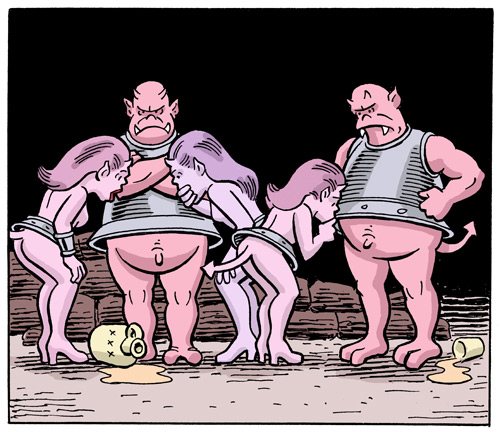
In October 2016, when I had completed 48 strips, I got an email from Peter Karpick, a cartoon editor at the entertainment company Adult Swim. He asked if I would like to develop a series for the comics section of their website. I told him I had already developed a series and would be happy to have them use it as long as I retained ownership and publication rights. They agreed to this and paid me very well for the 19 strips they ran at their site. Those strips are currently archived on the Adult Swim comics page.
By the summer of 2018, when I had over 80 strips, I did the additional material necessary for the collection of them to be published by Editions Tanibis. This included front and back covers; the map on the end papers; five comic pages to introduce Hieronymus and Bosch and show how they ended up in Hell; some short strips based on ideas that didn't require a full page; and an afterword from Satan.
— Paul Kirchner
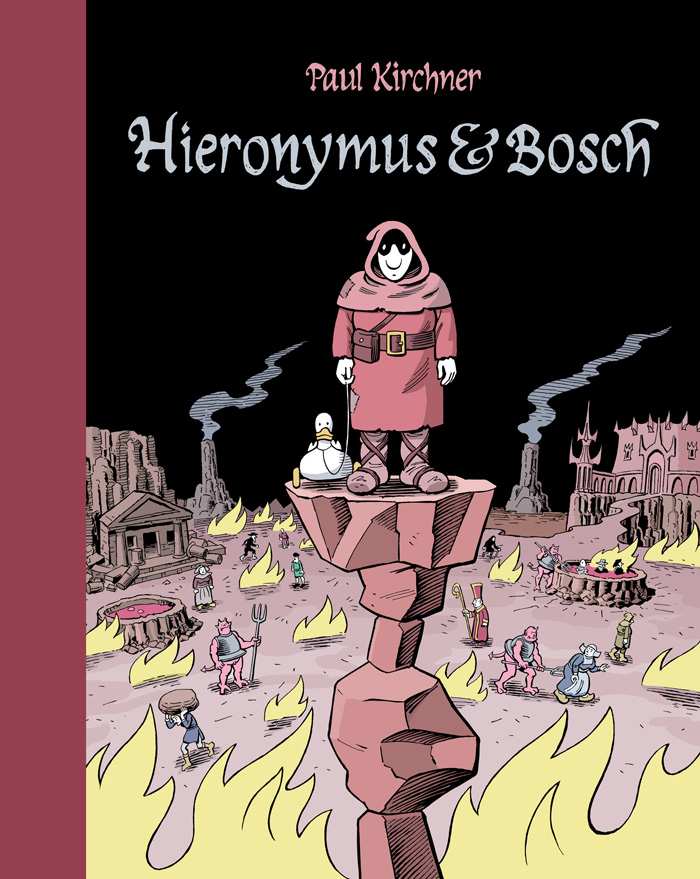
/// aucun commentaire ///
mardi 5 décembre 2017 - Galeries Paul Kirchner
À l'occasion de son numéro annuel spécial « Baby Boomers », le quotidien américain le Boston Globe demanda en 2015 à Paul Kirchner d'évoquer en bande dessinée son parcours atypique. À l'occasion de la parution de l'anthologie En attendant l'Apocalypse, nous publions sur notre blog la traduction française de ce récit autobiographique.
/// aucun commentaire ///
mardi 14 novembre 2017 - Nouveauté
Aujourd'hui en librairie :
Après avoir remis le bus de Paul Kirchner en orbite avec deux volumes publiés en 2012 et 2015, Tanibis poursuit son exploration des mondes divergents de l’auteur américain à travers une anthologie rassemblant des récits courts et illustrations réalisés dans les années 70 et 80 pour divers magazines emblématiques de la contre-culture, ainsi que d’autres travaux plus récents, parfois inédits.
On y croise Dope Rider, sac d’os défoncé poursuivant des quêtes improbables dans un univers psychédélique que l’on pourrait situer entre les westerns de Sergio Leone et les tableaux de Salvador Dalí. Alternant non sequiturs et logique floue, les aventures de Dope Rider, publiées en leur temps dans le magazine High Times, sont également pour l’auteur une façon de s’essayer à une forme singulière de poésie graphique.
Dans une même veine subversive, l’ouvrage reprend également une sélection d’histoires où il est question d’invasion sextraterrestre, de voyages spirituels vers des mondes shamaniques, d’univers totalitaires inspirés de la société des abeilles ou encore, littéralement, de l’Apocalypse biblique.
Enfin, En attendant l’Apocalypse rassemble une bonne partie des couvertures réalisées par Kirchner pour le magazine pornographique Screw. On y retrouve son trait précis et son goût pour l’humour et le surréalisme.
L’ouvrage est complété d’une copieuse postface de l’auteur dans laquelle il resitue ses travaux dans leur contexte et revient sur son parcours atypique, de ses débuts comme assistant de Wallace Wood à son retour à la bande dessinée en 2012.
À noter que l’ouvrage est également publié en version anglaise sous le titre Awaiting the Collapse (isbn 978-2-84841-044-9).
/// aucun commentaire ///
vendredi 20 novembre 2015 - Entretiens
En novembre 2015, Paul Kirchner est de retour avec le bus 2, recueil de 48 nouveaux strips dessinés entre 2013 and 2015. En 2014, Stefan van Dinther et Eric van der Heijden se sont entretenus avec Paul Kirchner pour le magazine néerlandais Zone 5300. L'entretien a été réalisé par e-mail, la retranscription a été relue et corrigée par Paul Kirchner. La traduction de l’anglais a été effectuée par Hugo Polizzi.
Entretien également disponible en anglais.

Zone 5300 : Nous avons lu différentes choses au sujet de vos origines sur internet. Êtes-vous né en Allemagne ou à New Haven dans l’État du Connecticut ? Est-ce que vous percevez une influence de vos origines européennes sur votre travail ?
Paul Kirchner : Je suis né à New Haven dans le Connecticut. J’ignore comment l’autre rumeur est née. C’est mon arrière-grand-père qui est venu au monde en Allemagne.
Zone 5300 : Êtes-vous issu d’une famille d’artistes ?
P.K. : Oui, mes deux parents avaient des prédispositions artistiques. Mon père était « l’artiste de sa promotion » au lycée et il a intégré l’école d’art du Maryland après avoir obtenu son diplôme du secondaire. Pourtant, pendant la Grande Dépression, il est tombé sur des artistes qui vendaient leurs peintures dans la rue, pour pas un sou. Ces dernières étaient meilleures que ce qu’il s’imaginait pouvoir faire lui-même. Il a alors douté de sa capacité à gagner sa vie comme artiste et est devenu médecin.
Ma mère, qui est franco-canadienne, a été diplômée de l’école des beaux-arts de Montréal et a travaillé comme illustratrice médicale avant de se marier avec mon père.

Zone 5300 : Vous travaillez de nouveau sur le bus après une pause de presque 28 ans. Avez-vous glané des idées de gags pendant ce laps de temps ? Avez-vous eu du mal à reprendre où vous vous étiez arrêté ?
P.K. : Je ne cherchais aucunement à avoir des idées. À vrai dire, j’en étais même venu à douter de mon aptitude à trouver des idées de ce genre. Je me disais que la bizarrerie en bandes dessinées était peut-être le privilège de la jeunesse, tout comme le rock. Au milieu des années 1980, j’ai cessé de travailler sur le bus ; j’avais beaucoup à faire avec mon activité commerciale, la conception de jouets et la publicité. Ces dernières années, mon activité en freelance a ralenti de manière préoccupante en raison de la récession économique. Dans les années 1970 et 1980, époque où je n’étais pas encore sous contrat, j’ai eu l’occasion de dessiner des bandes dessinées et de les vendre à des revues telles que Heavy Metal, High Times et Screw. Il me restait toujours cette alternative. Les magazines ne sont plus un marché porteur, mais j’ai senti que je devais essayer de relancer le bus et voir si quelqu’un était susceptible de le publier [1]. J’ai pensé que ce projet avait ses chances. Il y a eu un regain d’intérêt suite à la publication de l’anthologie de Tanibis et j’ai reçu des mails de fans des quatre coins du monde. L’ego d’un artiste étant insatiable, c’était très gratifiant.
Je n’étais pas certain de pouvoir reprendre ce travail, mais lorsque j’ai recommencé à me concentrer sur le bus, sans autre projet sur le feu, les idées ont commencé à germer. Comme par le passé, je me suis mis à prendre en note chacune des drôles d’idées qui me passaient par la tête, aussi insolites soient-elles. Je conserve ces idées dans un dossier et je les consulte régulièrement pour voir si je peux creuser l’une d’entre elles. Parfois, une idée qui ne suffit pas à elle seule fonctionne lorsqu’on la combine à une autre. Mais le plus beau, c’est lorsqu’une idée totalement achevée me vient à l’esprit ; cela arrive de temps à autre.
Le fait de travailler sur les nouveaux strips du bus a amélioré mon état d’esprit, dégradé par la rareté des contrats rémunérés. Dessiner de nouveaux strips du bus me permettait au moins de parachever un travail. En tant qu’artiste, on doit continuer à créer et espérer que quelque chose s’ensuive.
Zone 5300 : Selon vous, ces nouveaux épisodes se distinguent-ils de ceux que vous avez faits pour Heavy Metal ?
P.K. : Claude Amauger, éditeur chez Tanibis, y constate de nouvelles thématiques, mais globalement, il considère qu’elles « rendent » comme si je les avais enfouies depuis les années 1980. J’ai essayé de maintenir un rapport cohérent avec les anciens strips. Les autobus modernes ne ressemblent plus à ceux d’il y a 30 ans, mais je ne pouvais me résoudre à remanier le bus (les nouveaux sont rectangulaires et n’ont aucun cachet ; difficile de distinguer l’avant de l’arrière). Le protagoniste, le passager, est resté identique — mais on voit toujours ce look aujourd’hui — et j’ai remis les vêtements et les coiffures des personnages secondaires au goût du jour. Je me souviens des comic strips que je lisais dans les journaux, étant jeune. L’apparence des personnages était immuable et ils portaient leurs habits des premiers strips, même si ces derniers remontaient à 30 ou 40 ans. Vous verrez ce dont je parle si vous jetez un œil à Bringing Up Father (La Famille Illico), Mutt and Jeff ou They’ll Do It Every Time. Leurs styles dataient d’une époque révolue ; ce n’est pas ce que je voulais faire.
Une chose a changé et j’ose espérer qu’elle n’est pas perceptible : avant, j’avais recours à une plume Gillot 170 et une encre de Chine sur un papier vélin 3 plis Strathmore. Toutefois, la qualité du papier n’est plus vraiment ce qu’elle était et je ne peux plus utiliser ces stylos d’un autre temps parce que le tracé bave affreusement. Désormais, je fais mes encrages avec un feutre « PITT artist pen » de Faber-Castell à la pointe extrafine. Ceci a bien fonctionné.

Zone 5300 : Voyez-vous un mûrissement artistique dans les épisodes de le bus que vous avez fait pour Heavy Metal ?
P.K. : La facture varie considérablement entre les dix premiers strips et ceux qui ont suivis. Les dix premiers étaient des échantillons que j’avais réalisés pour un quotidien. Je m’attendais à une impression de grandes dimensions, c’est pourquoi je les ai dessinés sur deux pages (35,6 cm x 50,8 cm) et encrés d’un trait fin. Lorsque ces épisodes ont été publiés dans Heavy Metal, leur taille avait été réduite d’environ 35 % et le trait n’était pas assez épais. J’ai continué de travailler dans ce format, mais j’ai réalisé mon encrage avec un trait plus épais.
Zone 5300 : Vous avez déclaré dans l’interview de The Comics Journal [2] que vous étiez influencé par l’art et le cinéma surréalistes. Prenez-vous aussi les bandes dessinées comme source d’inspiration pour le bus ? Vous estimez-vous au courant des développements récents du marché de la bande dessinée ?
P.K. : Au jour d’aujourd’hui, je ne suis plus en phase avec l’industrie de la bande dessinée. Ma fille m’a montré Sandman, la série des années 1990 de Neil Gaiman dont j’admire les scenarii et le dessin. Puis, Frank Miller m’a fait grande impression avec Sin City et 300, davantage qu’avec son Batman. Je n’ai pas vu grand-chose d'autre qui m’ait réellement émerveillé, mais il y a beaucoup de choses que je n’ai pas vues…
Après avoir relancé le bus, je l’ai soumis à High Times pour voir s’ils étaient intéressés. Ils ont décidé de ne pas donner suite à ce projet mais ils m’ont quand même demandé de relancer le personnage de Dope Rider que j’avais créé pour eux dans les années 1970 et de publier une page tous les mois. Cela fait maintenant plus d’un an. Ils sont très enthousiastes et me disent qu’ils adorent son aspect « vintage ». Cela dit, étant moi-même une personne « vintage », c’est la seule façon de dessiner que je connaisse.

Zone 5300 : Nous sommes curieux de savoir quels sont les épisodes de le bus que vous préférez et d’entendre ce que vous pouvez nous en dire.
P.K. : En revoyant mes strips, il y en a certains pour lesquels il m’est facile de repérer d’où provenait l’idée de départ. Si je reprenais la série du début, je suis persuadé que ces idées-là me reviendraient à l’esprit. Pourtant, il y a d’autres strips pour lesquels je me demande « D’où m’est venu cette idée ? Comment y ai-je pensé ? » quand je les vois ; ce sont ceux que je préfère.
Par exemple, celle dans laquelle le bus s’arrête au bord d’un pont écroulé et s’embouteillant, les voitures commencent à klaxonner ; celle dans laquelle le chauffeur peint un bus qui, une fois parti, laisse un espace blanc sur lequel le chauffeur se met à peindre un nouveau bus ; celle dans laquelle le bus pose pour Playboy ; celle dans laquelle l’homme qui attend le bus est un pantin en papier que le chauffeur remplace par un homme assis, personnage découpé qu’il va chercher dans une zone de stockage d’autres pantins en papier ; l’agent de circulation orientant des bus qui arrivent dans tous les sens, horizontalement et verticalement.
Je suis aussi terriblement séduit par plusieurs des nouveaux épisodes. Je suis content quand ils font rire ma femme aux éclats, puisqu’elle est toujours prête à me le faire savoir quand elle estime que l’un d’entre eux coince.

Zone 5300 : Comment vous expliquez-vous qu’en ce moment votre travail soit réévalué ?
P.K. : Le mérite revient en grande partie au raffinement de l’édition publiée par Tanibis, ayant fait paraître mes travaux dans une qualité bien supérieure à ce qu’avait fait Ballantine dans sa collection de 1987, mais également au degré d’attention que les strips ont retenu sur internet.
Internet est un outil à double tranchant. D’une part, il permet à de nombreuses personnes de consulter votre travail. D’autre part, il minimise les chances d’être rétribué en retour. Les internautes s’attendent à accéder gratuitement à tous les contenus. Aujourd’hui, les auteurs de bandes dessinées déposent leur travail sur internet et prient pour que cela mène à quelque chose, mais en attendant, ils doivent avoir une autre source de revenu. Il y a 30 ou 40 ans, quand les revues prospéraient encore, on pouvait faire des bandes dessinées et toucher un salaire en échange, c’était le bon temps !
Zone 5300 : Dans l’interview de The Comics Journal vous avez déclaré avoir été déçu du texte de Janwillem van de Wetering pour Murder by Remote Control (pour ce que cela vaut : nous avons lu récemment le livre et n’avons pas trouvé que le texte était trop explicatif). Vous espériez que sa plume ait porté le livre à un autre niveau. Comment l’aviez-vous imaginé ?
P.K. : À l’époque, j’avais espéré que l’écriture donnerait à l’histoire un degré de profondeur supplémentaire. Pourtant j’ai senti que le texte n’ajoutait que peu d’informations à ce qui pouvait être compris en regardant les dessins — voilà ce que j’entendais par explicatif.
C’était ma première impression, que j’avais toujours au moment de l’interview du Comics Journal. Pourtant, j’ai relu récemment le récit qui va être réédité par Dover Publications en 2016 et, avec un regard neuf, je me suis rendu compte que j’aimais le style dépouillé de l’écriture.
J’étais déçu que le livre n’ait pas plus fait parler de lui et qu’il n’ait généré aucunes royalties pour moi, mais simplement une modeste avance de 12 $ par page. J’avais le sentiment de m’être investi pendant une année dans un projet sans obtenir grand-chose en retour. Mais l’écriture n’avait peut-être rien à voir avec cela. On jette les dés à chaque fois qu’on entreprend un projet créatif. On ne sait jamais quel accueil va recevoir son travail.
Du côté du positif, j’ai noué une amitié durable avec Janwillem, qui était une personne fascinante et qui m’a influencé à bien des égards. Il a une place dans ma shortlist des personnes vraiment remarquables que j’ai connues. Nous nous sommes régulièrement écrits jusqu’à ce qu’il nous quitte et ma femme et moi lui rendions très souvent visite dans le Maine.
Zone 5300 : Les visions de Jim Brady sont hautement visuelles, le livre, dans sa totalité, est hautement visuel. Cet aspect est-il issu de votre collaboration, ou était-il de votre propre cru ?
P.K. : L’aspect visuel vient de moi, mais je suis sûr que Janwillem voulait que j’aille dans ce sens, puisque c’était mon comic strip — Dope Rider — qui l’avait poussé à travailler avec moi. J’ai conservé son premier synopsis de l’intrigue, décrivant certaines de ses idées pour le visuel. En haut, il a noté : « C’est l’idée, il me semble, mais tu es libre d’y renoncer et de l’améliorer, je t’invite même à le faire ; les bulles émanant de ton subconscient sont tellement plus claires que les miennes. »

Zone 5300 : Le passage d’une scène à l’autre se fait très rapidement et de manière soudaine. Aviez-vous une raison pour vous y prendre ainsi ?
P.K. : Dans Dope Rider, je changeais brusquement de situations pour refléter la fugacité des pensées ou des états d’esprit, et j’ai appliqué cette méthode à Murder by Remote Control.
Zone 5300 : Nous sommes de grands fans de la série Twin Peaks et nous voyons chez Jim Brady, une sorte de précurseur de l’agent Cooper. Que pouvez-vous nous en dire ?
P.K. : J’ai bien peur de n’avoir jamais vu Twin Peaks. Je ne regarde pas beaucoup la télévision, y compris les bonnes émissions dont tout le monde parle. Je ne veux pas avoir l’air d’une personne qui se vante de ne pas regarder la télévision, c’est simplement que je n’en ai jamais pris l’habitude.
Zone 5300 : Et avez-vous des projets pour réinsuffler la vie à Jim Brady ?
P.K. : Nous avons eu beaucoup de mal à trouver un éditeur américain pour Murder by Remote Control. Un d’entre eux nous a dit que c’était trop européen, pas adapté au marché américain. Un autre nous a affirmé que cela lui rappelait Fritz the Cat, probablement la seule autre bande dessinée sans super-héros dont il connaissait l’existence. Nous avons été très soulagés de signer un contrat avec Ballantine au final. Une fois l’accord conclu, Janwillem a immédiatement voulu faire une suite, il m’a même envoyé un synopsis. Mais je n’avais pas l’énergie de me replonger dans un si gros projet et de toute façon, j’étais occupé par d’autres choses. Maintenant, sans Janwillem dans les parages, je ne m’imagine pas réaliser seul la suite.
Zone 5300 : Considérez-vous le bus comme votre meilleur œuvre ?
P.K. : C’est le travail pour lequel je suis le plus connu, donc l’idée qu’il s’agirait de ma meilleure œuvre peut faire consensus. En ce qui me concerne, je ne le vois pas ainsi. J’ai réalisé une grande variété de types de travaux, certains illustrent mes intérêts les plus personnels et d’autres répondent à des missions commerciales. J’ai pris du plaisir et trouvé de la satisfaction dans chacun d’eux.
Zone 5300 : Vous êtes passé de la bande dessinée à l’industrie du jouet, mais lorsqu’on observe les bandes que vous avez dessinées, ceci ne semble pas être une reconversion logique. Pouvez-vous éclaircir ce point ?
P.K. : J’ai commencé assez tôt à travailler pour l’industrie du jouet, vers 1980. Le directeur artistique d’une entreprise de fabrication de jouets avait vu une couverture que j’avais faite pour Screw ; il en a apprécié le style et il a voulu me rencontrer pour discuter d’un projet : une ligne de figurines militaires appelée l’Eagle Force. J’y ai travaillé pendant plus d’un an. L’entreprise a fait faillite, puis les gens avec qui j’avais travaillé sont partis dans d’autres entreprises et ont continué à faire appel à moi pour de l’illustration, du design et de la conception-rédaction. En fin de compte, toutes les entreprises pour lesquelles j’ai travaillé ont mis la clef sous la porte et toutes les personnes que j’ai connues ont pris des chemins différents ; c’est ainsi que j’en ai terminé avec ce domaine d’activité.

Zone 5300 : Vous avez également écrit plusieurs livres de non-fiction, alors que vous aviez déclaré dans l’interview de The Comics Journal que vous n’étiez pas toujours satisfait de votre écriture pour le bus. Avez-vous plus de mal à écrire de la fiction ou de la non-fiction ?
P.K. : Je crois n’avoir aucun talent comme écrivain de fiction — mon écriture est trop explicative, pour réutiliser ce mot. Si je peux avoir des idées d’histoires, je préfère les calquer au minimum sur la réalité. C’est parce que j’aime approfondir des sujets qui m’intriguent et présenter d’une façon claire et plaisante ce matériau au lecteur, qu’il m’a semblé plus facile d’écrire de la non-fiction.
Zone 5300 : Vous avez toutes les compétences d’un professionnel américain de la bande dessinée, mais nous sentons que vous avez l’âme d’un artiste indépendant. Ceci donne l’impression d’une légère dichotomie dans votre œuvre. Qu’en pensez-vous ?
P.K. : À l’origine, j’espérais devenir dessinateur professionnel pour Marvel ou DC, mais je ne semblais pas fait pour cela. La plus honorable des tâches dans le domaine du comics consistait à dessiner des super-héros, mais cela ne m’intéressait pas. Les planches devaient être dessinées sous un agrandissement de 150 %, mais moi je préférais travailler avec un agrandissement de 200 %. Mes dessins n’étaient pas aussi raffinés qu’ils auraient dû l’être. Pendant que d’autres dessinateurs pouvaient produire plusieurs pages par jour, finir de crayonner une page me prenait plusieurs jours ; j’étais trop lent. Donc, l’idée de faire de l’art selon ma propre vision me séduisait, mais j’ai toujours travaillé lentement et remis les choses au lendemain.
En me mettant à accomplir des missions commerciales, mes habitudes de travail se sont considérablement améliorées. J’avais une tâche spécifique, les directeurs artistiques me faisaient part de leurs retours, les délais m’ont forcé à travailler efficacement et le job était bien payé. Quand je remplis des missions commerciales, je suis moins anxieux et je ne me reproche pas mon manque de productivité à longueur de journées. C’est la raison pour laquelle, lorsqu’on a commencé à me proposer des contrats de travail permanents, j’ai mis mes projets personnels en suspens. J’entends bien que cela ne donne pas l’impression d’un artiste dans l’âme, mais j’avais une famille à nourrir.
Zone 5300 est depuis 1994 le principal magazine néerlandais de bande dessinée alternative. Paraissant quatre fois par an, imprimé en couleurs sur papier glacé, le magazine entend fait connaître à son lectorat le travail d'auteurs de bandes dessinées venant du monde entier.
Merci à Stefan van Dinther, Eric van der Heijden et Hugo Polizzi.
/// aucun commentaire ///
vendredi 20 novembre 2015 - Entretiens
In November 2015, Paul Kirchner is back with the bus 2, a collection of 48 new strips drawn between 2013 and 2015. In 2014, Stefan van Dinther and Eric van der Heijden interviewed Paul Kirchner for the Dutch magazine Zone 5300. The interview was conducted via email and Paul Kirchner copy-edited the transcript.
This interview is also available in French.
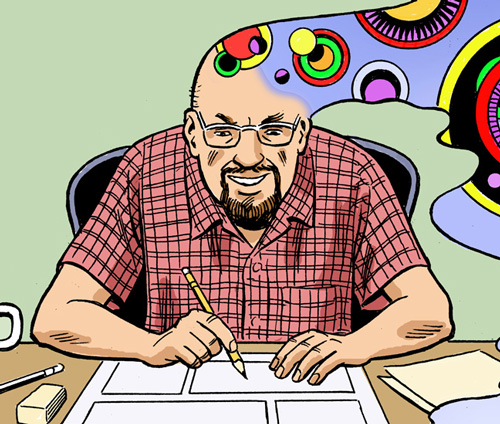
Zone 5300 : About your descent we read different things on the internet. Were you born in Germany or in New Haven, Connecticut ? Do you see the influence of your European descent in your work ?
Paul Kirchner : I was born in New Haven, Connecticut. I don't know how the other rumor got started. It was my great grandfather who was born in Germany.
Zone 5300 : Do you come from an artistic family?
P.K. : Yes, both my parents had artistic ability. My father was the "class artist" when he was in high school and enrolled in the Maryland Institute of Art after graduating. This was during the Depression, though, and he saw artists in the streets trying to sell paintings that were better than he could imagine doing himself, and they were asking almost nothing for them. He doubted his ability to make a living as an artist and became a doctor instead. My mother, who is French-Canadian, graduated from the School of Fine Arts in Montreal and worked as a medical illustrator before marrying my father.
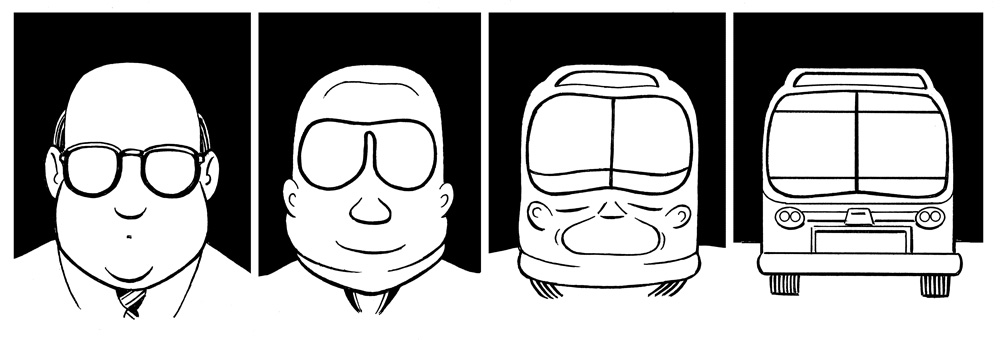
Zone 5300 : After a break of about 28 years you’re working on the bus again. Have you been collecting ideas for gags in the years between? Was it difficult to pick up where you left off?
P.K. : I hadn't been thinking of ideas at all; in fact, I had come to doubt my ability to come up with ideas of this sort. I thought that weird comics were perhaps the domain of the young, like rock music. In the mid-1980s I stopped doing the bus because I had become busy with commercial work, toy design, and advertising. In recent years, due to the downturn in the economy, my freelance work has slowed down to a worrying extent. In the 1970s and 1980s, when I didn't have an assignment, I would draw up cartoons and sell them to magazines such as Heavy Metal, High Times, and Screw. I always had that option. The magazine industry is not a good market anymore, but nevertheless I felt I should try to relaunch the bus and see if anyone would publish it [1]. I felt it had a chance. There was renewed interest after the publication of the Tanibis anthology and I was getting fan mail from all over the world. The artist’s ego is always hungry, so that is very gratifying. I wasn’t sure I could still do it, but once I began to focus on the bus again, with no other projects to think about, ideas began to come. As I did in the past, I began jotting down every odd idea that popped into my head, however strange. I keep the ideas in a file and look through it regularly, to see if any can be developed. Sometimes an idea that is insufficient on its own will work when you combine it with another idea. Best of all is when an idea appears in my mind fully realized, which happens now and then. Working on the new bus strips has improved my mood, which had been down due to the shortage of paying assignments. At least in drawing new bus strips I was accomplishing something. As an artist you have to keep creating and hope something comes of it.
Zone 5300 : Do you feel that the new episodes differ from the ones you’ve made for Heavy Metal ?
P.K. : Claude Amauger, the publisher at Tanibis, says he detects some new themes, but all-in-all he thinks they look as if I had hidden them away since the 1980s. I’ve tried to maintain a seamless connection to the earlier strips. Today’s buses no longer look the way they did 30 years ago, but I couldn’t bear to change the bus. The new ones are boxy and have no personality. You can hardly tell the front from the back. The main character, the Commuter, looks the same, but his look is one you still see and I have updated the way the other passengers dress and wear their hair. I remember the newspaper comic strips of my youth, where the characters all looked and dressed the same way they had when the strip originated, even if it was 30 or 40 years earlier. If you look up Bringing Up Father, Mutt and Jeff, or They’ll Do It Every Time you’ll see what I mean. The styles were stuck in a bygone age. I didn’t want to do that. One thing that has changed, and I hope it’s not noticeable, is that I used to work with a Gillot 170 pen and India ink on Strathmore 3-ply vellum paper. The quality of the paper is not nearly what it used to be, though, and I can no longer use the old-fashioned pen because the line bleeds terribly. I now ink with Faber-Castell’s “Pitt” artist pen with the superfine point. This has worked out well.
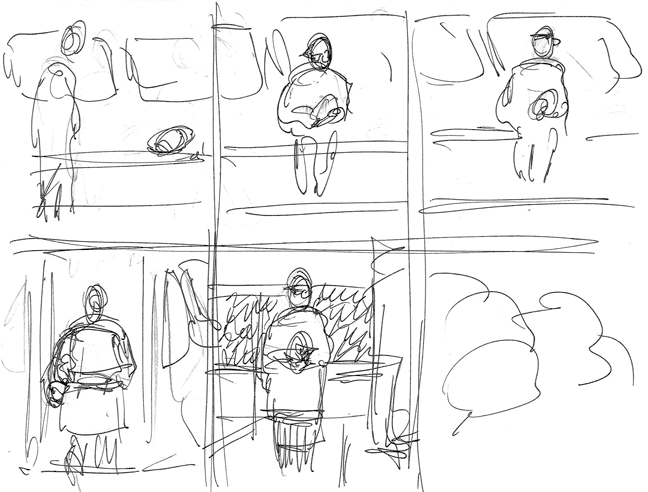
Zone 5300 : Do you see an artistic development within the episodes of the bus that you made for Heavy Metal ?
P.K. : The biggest difference in the look of the bus is between the first ten strips and those that came after. The first ten I did as samples for a weekly newspaper and expected them to be printed large, so I drew them twice-up—14” x 20”—and inked them with a fine line. When they appeared in Heavy Metal, they were reduced to about 35 percent, and the linework was too delicate. I continued to work at the same large size, but inked the art with a heavier line.
Zone 5300 : In The Comics Journal [2] interview you talked about being influenced by surrealistic art and cinema. Are there currently also comics that you use as an inspiration for the bus. Do you feel you’re still in touch with the developments within the comic business ?
P.K. : I’m out of touch with the comic industry these days. My daughter has introduced me to Neil Gaiman’s Sandman series from the 1990s, and I admire the stories and artwork. I was also very impressed with Frank Miller’s Sin City and 300, much more so than his Batman. I haven’t seen much else that really grabbed me, but then there is a lot I haven’t seen. After I relaunched the bus, I submitted it to High Times to see if they were interested. They didn’t choose to run it, but they did ask me to relaunch the Dope Rider character I did for them in the 1970s and to do a page a month. I've now been doing the strip monthly for over a year. They’re very excited about it and tell me they love its “vintage” look. Of course, as a vintage person, it’s the only way I know how to draw.
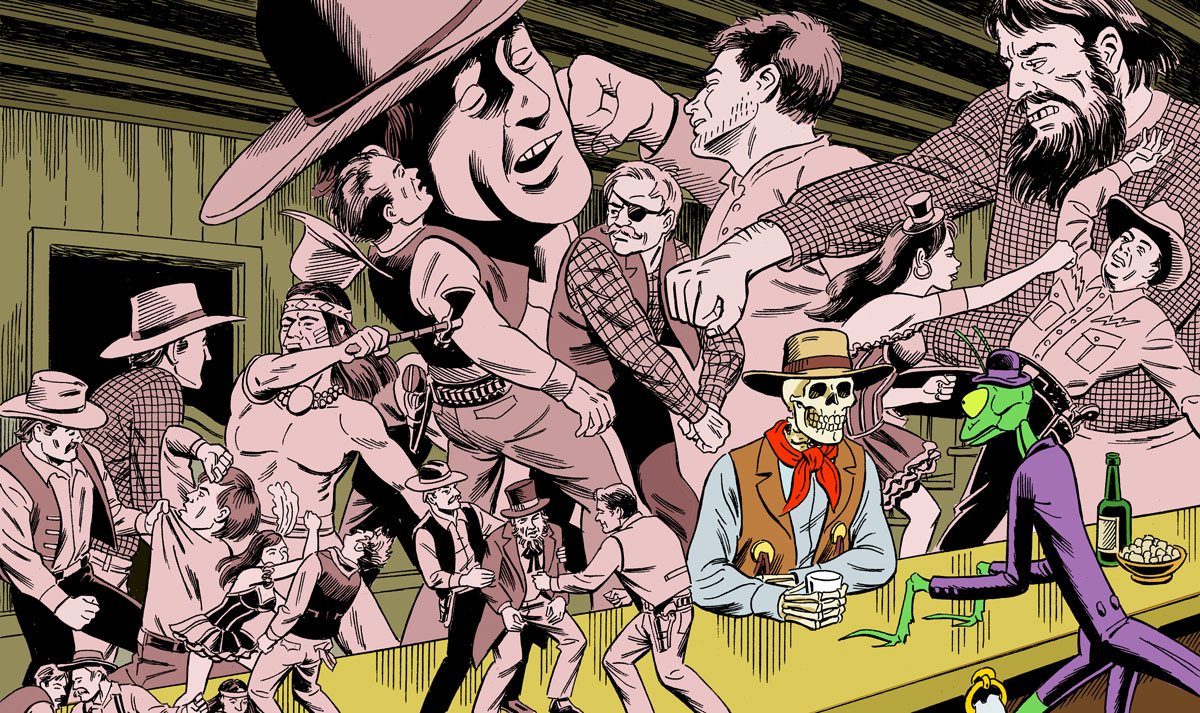
Zone 5300 : We are very curious to find out what your personal favorite episodes of the bus are and what you can tell us about these episodes.
P.K. : Looking through the strips, there are some in which I can easily understand where the idea came from. If I were starting the series over again from the beginning, I’m sure these same ideas would occur to me. There are other strips, though, that I look at and wonder, “Where did that idea come from? How could I have thought of that?” Those are my favorites. For example, the one where the bus stops at the edge of a broken bridge and the traffic behind it begins honking; the one where the bus driver is painting a bus and then it drives away, leaving blank space on which he begins painting a new one; the one where the bus poses for a photo spread in Playboy; the one where the man waiting for the bus is a cut-out that the driver replaces with a sitting man from a storage area of other cut-outs; the traffic cop directing buses coming from all directions, horizontal and vertical. I am also very excited about several of the new ones. I am pleased when they make my wife laugh out loud, as she is always willing to let me know when she thinks one isn’t working.

Zone 5300 : Do you have an explanation why at this moment your work is being re-appreciated?
P.K. : I attribute it mostly to the exquisite edition put out by Tanibis, which reproduced them at much higher quality than did Ballantine in the 1987 collection, and also the amount of attention the strips have gotten on the internet. The internet is a two-edged sword. On the one hand, it enables many people to see your work. On the other hand, it has made it more difficult to get paid for it. The internet audience expects to get everything for free. Cartoonists today put their work on the internet and hopes it leads to something, but meanwhile they must have another source of income. How great it was 30 or 40 years ago, when magazines still thrived, to be able to do cartoons and get paid for them!
Zone 5300 : In The Comics Journal interview you talked about being disappointed with Janwillem van de Wetering's scripting for Murder by Remote Control (for what it’s worth: when we read the book recently we didn't think the writing was too expository). You had hopes that his writing would take the book to a new level. In what way had you imagined that?
P.K. : At the time, I had hoped that there would be a deeper level to the story that would come out in the writing and I felt the text added little that couldn’t be understood from just looking at the artwork—that’s what I meant by expository. That was my initial impression, and one which I held onto afterward. However, I recently reread the story as it is going to be reprinted by Dover Publications in 2016, and, coming to it fresh, I found I liked the spare quality of the writing.
I was disappointed that the book didn’t make much of a splash and generated no royalties for me, only a modest advance that worked out to $12 a page. I felt I had invested a year in a project with very little to show for it. But the writing may have had nothing to do with that. You are rolling the dice on any creative endeavor. You never know how it will be received by the public.
On the positive side, I formed a lasting friendship with Janwillem, who was a fascinating person and who influenced my outlook in many ways. He is on the short list of truly remarkable people I have known. We corresponded regularly up to his death and my wife and I visited him at his place in Maine many times.
Zone 5300 : The visions of Jim Brady are very visual, the entire book is very visual. Did you make up the visions together with Janwillem, or was that just you?
P.K. : The visuals are mine, but that’s definitely the direction Janwillem wanted me to take, as it was my Dope Rider comic strip that inspired him to work with me. I still have his initial plot outline, which describes some visual ideas. At the top of it he wrote, “the idea, methinks, but you’re free to discard & improve, in fact I invite you to for your bubbles from the Subconscious are so much clearer than mine.”
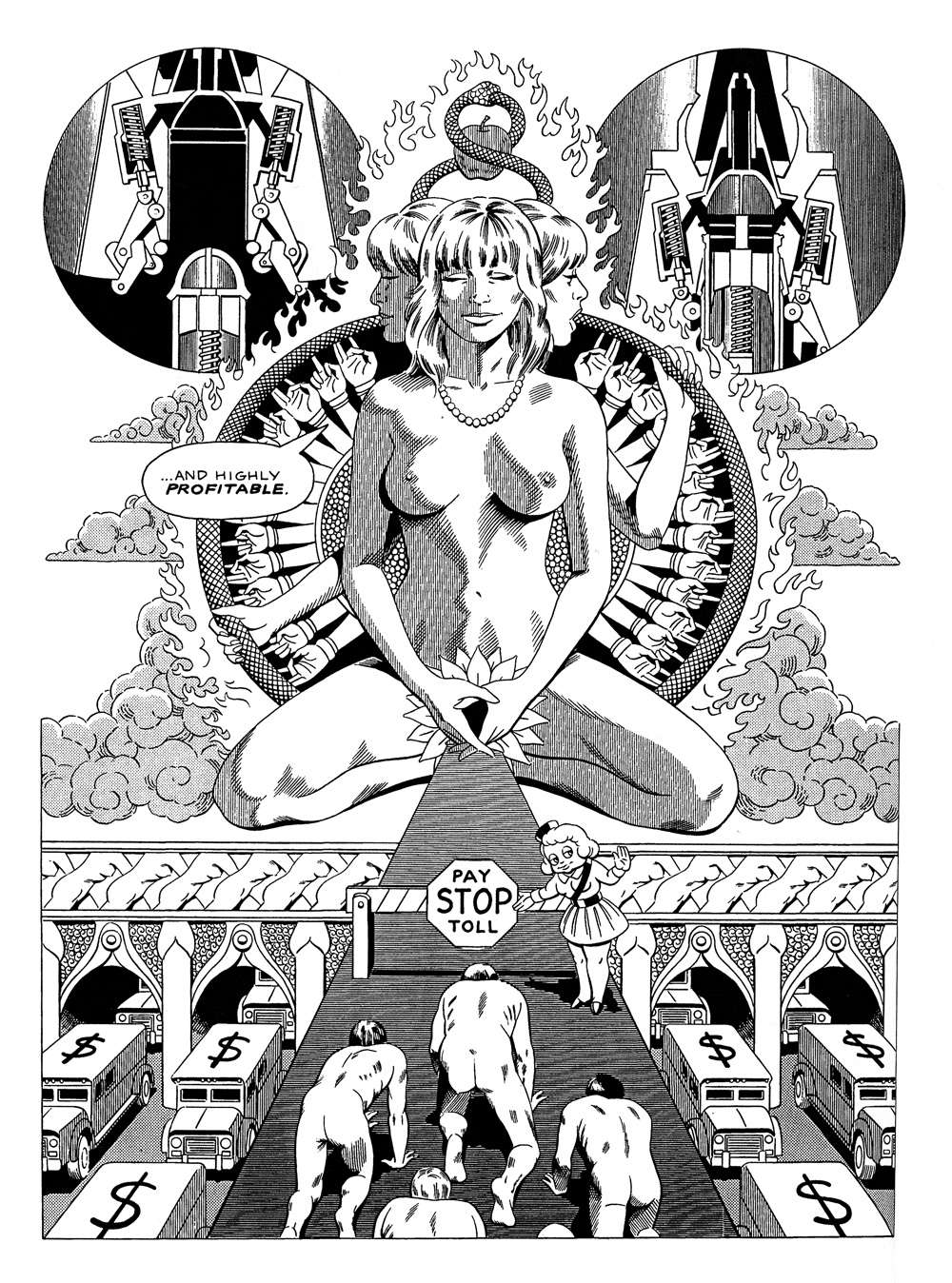
Zone 5300 : The changes from scene to scene are very fast and kind of sudden. Did you have a reason for this approach?
P.K. : In Dope Rider, I abruptly change situations to reflect fleeting thoughts or moods, and I applied that approach to Murder by Remote Control.
Zone 5300 : We are big Twin Peaks-fans and we see in Jim Brady a kind of precursor of Agent Cooper. Can you relate to that?
P.K. : I’m afraid I’ve never seen Twin Peaks. I don’t watch much television, even the good programs everyone talks about. I don’t mean to sound like I’m bragging about not watching television, it’s just that I’ve never gotten in the habit of it.
Zone 5300 : And do you have plans to breathe life into Jim Brady again?
P.K. : We had a lot of difficulty placing Murder by Remote Control with an American publisher. One said it was too European, not suitable for the American market. Another said it reminded him of Fritz the Cat, evidently the only non-superhero comic he was aware of. It was a relief when Ballantine finally gave us a contract. Once we had the deal, Janwillem immediately wanted to do a sequel and even sent me a plot outline. However, I couldn't work up the energy to plunge into such a big project again and anyway I had gotten busy with other things. Now, without Janwillem around to collaborate, I can't imagine doing it alone.
Zone 5300 : Do you consider the bus as your best work ?
P.K. : It’s the work I’m best known for, so the consensus may be that it’s my best work. As for me, I don’t look at it like that. I’ve done a lot of different sorts of work, some of it representing my more personal interests and some to meet commercial assignments. I find enjoyment and take satisfaction in all of it.
Zone 5300 : You changed from making comics to working for toy factories, but when one looks at the comics you drew, that doesn't seem like a very logical step. Can you explain this ?
P.K. : My association with toy companies started early, around 1980. An art director at a toy company saw a cover I did for Screw, liked the style of it, and wanted to meet me to talk about a project, a line of toy soldiers called the Eagle Force. I worked on that for over a year. After the company went bankrupt the people I had worked with went to other companies and continued to hire me for illustration, design, and copy writing. Eventually, all the companies I worked for went out of business and all the people I knew went in other directions, so that line of work ended for me.
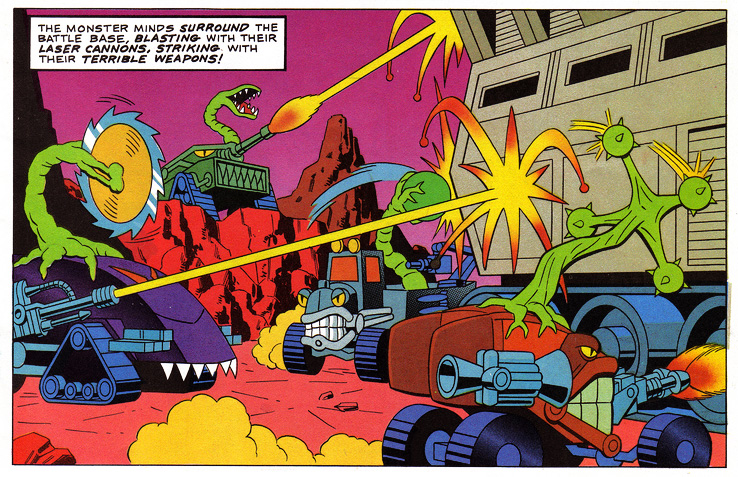
Zone 5300 : You have also written several non-fiction books, whereas also you said in The Comics Journal interview that you are not always satisfied with your writing for the bus. Is it harder for you to write fiction than non-fiction ?
P.K. : I don’t feel I have talent as a fiction writer—my writing is too expository, to use that word again. I can come up with story ideas but prefer that they have minimal copy. I find it easier to write non-fiction because I enjoy researching topics that interest me and presenting the material to the reader in a clear and interesting way.
Zone 5300 : You have the skills of an American comics professional, but we feel you have the heart of an autonomous artist, which feels like a bit of a split in your work. Can you relate to that ?
P.K. : I originally hoped to be a regular comic artist, working for Marvel or DC, but I didn’t seem to be suited for it. The most prestigious work in the comics field was drawing superheroes, and that didn’t interest me. The comics had to be drawn at a 150-percent enlargement, while I preferred working at 200 percent. My drawing was not as polished as it needed to be and I was too slow. Others could draw several pages a day, while it could take me several days to finish penciling a page. So I gravitated to doing my own art, but I always worked slowly and procrastinated over it. When I began to get commercial assignments, I found my work habits improved greatly. I had a specific task, the art directors provided feedback, the deadlines made me work efficiently, and the work paid well. When doing commercial assignments I have less angst and am not always kicking myself for my lack of productivity. This explains why I put my own projects aside when I began getting steady assignments. I understand that that doesn’t sound like the spirit of the true artist, but I had a family to support.
Zone 5300 is Holland’s leading alternative comics magazine since 1994. The magazine appears four times a year in full color on glossy paper. It takes pride in presenting comic creators from all over the world to its readership.
Many thanks to Stefan van Dinther and Eric van der Heijden.
/// aucun commentaire ///
« billets précédents - page 1 de 4